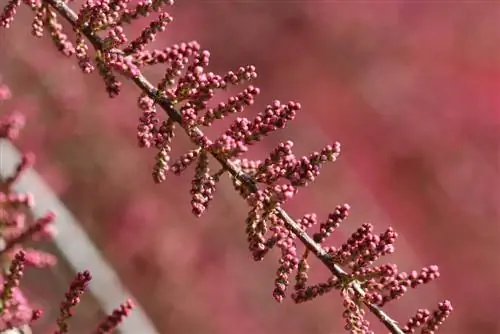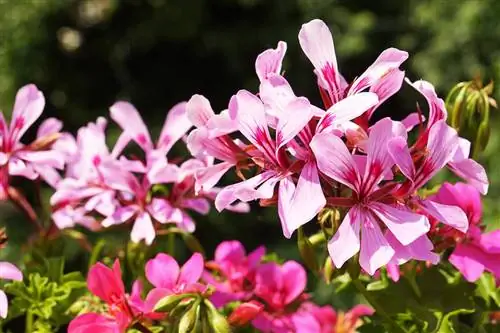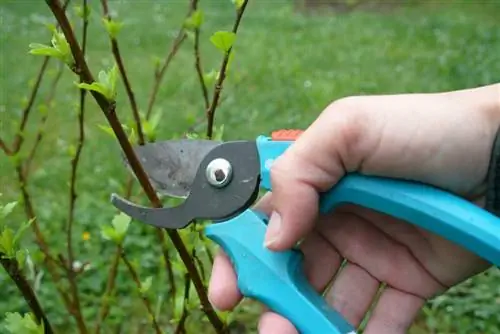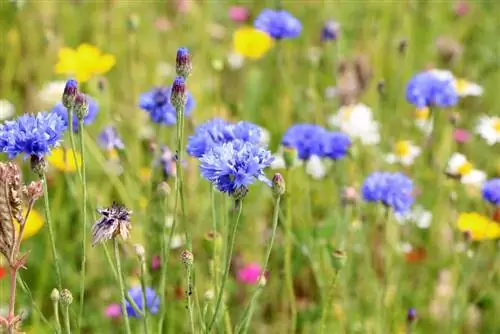- Author admin [email protected].
- Public 2023-12-17 03:39.
- Last modified 2025-01-24 12:45.
Where the summer tamarisk spreads its elegantly curved branches, it protects from prying eyes and serves as a powerful windbreak. When the pink flowers unfold from July to September, they not only magically attract everyone's attention, but also busy bees and fluttering butterflies. The Tamarix ramosissima Rubra fulfills its tasks as a majestic solitaire just as charmingly as it does as a distinctive part of a combined flower hedge. The ornamental tree says goodbye to the winter break with bright yellow leaves. The following care instructions explain all relevant aspects.
Location
With regard to the site conditions, the summer tamarisk proves to be extremely flexible. Basically, it thrives in any good garden soil as long as it is light enough to develop the magical flowers. The ornamental shrub achieves its optimum in the following locations:
- Sunny to partially shaded lighting conditions
- Preferably under the protection of a high wall, a fence or a pergola
- Nutritious, humus-rich soil
- Fresh-moist to sandy-dry
While the s alt content in the air and soil along sea coasts is not a problem, the summer tamarisk cannot cope with compacted soil or waterlogging. If in doubt, improving the soil solves the problem by incorporating either compost, leaf mold, sand or fine gravel.
Watering and fertilizing
It comes across as an incarnation of frugality, because a tamarisk Rubra makes do with a minimum in terms of water and nutrient supply. If the gardening calendar is once again bursting at the seams, it takes a modest back seat without the growth or flowering suffering.
- Only water when there is no rain
- Always give water directly to the roots
- Ideally water early in the morning or after sunset
- Summer amarisk does not need fertilizer in the bed
In the limited substrate volume of a pot, however, increased nursing attention is required. Watering is carried out as soon as the surface of the potting soil feels dry. Planted in pre-fertilized soil, there is no need to add fertilizer in the first year. The ornamental tree then receives a dose of liquid fertilizer for flowering plants every 4 weeks from April to August.
Tip:
A mulch layer of leaf mold, grass clippings or compost contributes to the well-being of a Tamarix in the bed.
Cutting

Annual topiary makes a valuable contribution to maintaining compact growth, a dense bloom and vitality. If you do not prune, sooner or later the ornamental shrub will go bald from the inside. Ultimately, only a few flowers bloom at the ends of the widely spaced branches. To prevent this from happening, cut the summer tamarisk like this:
- The best time is an overcast, frost-free day in March or April
- In the first step, thin out the entire bush thoroughly
- Cut dry branches at the base
- Cut off crossing and inward-facing branches
- Short young shoots that are too long by a third, maximum by half
- The tamarisk sprouts only hesitantly from a cut in the old wood
- Make each cut at an angle over an outward-facing bud
The Tamarix ramosissima Rubra is an excellent candidate for standard training. To do this, select the strongest, straight-growing branch on a bush that is as young as possible as the main shoot. Remove all side shoots consistently up to the desired crown height. It is important to note that this main shoot towers over all other branches by 15 to 20 centimeters. This creates a harmonious appearance and an advantageous juice scale.
Propagate
A vital summer tamarisk provides an abundance of suitable material for propagation through cuttings. If the tree is in full sap in early summer, this is the best time for this form of breeding. This is how it works:
- Cut off several half-woody shoot tips with a length of 15-20 centimeters
- Defoliate the lower part and cut away any buds that may be present
- Fill small pots with lean substrate, such as herb or potting soil
- Insert a cutting with the leafless part in there and water it
Place the cultivation pots in a warm, partially shaded garden spot. You can force the rooting process by putting a plastic bag over it. This should be ventilated daily to prevent mold from forming. During the following weeks, the substrate must neither dry out nor be completely submerged in water. If the process goes as desired, fresh shoots will soon appear or the first roots will grow out of the opening in the ground. Once the summer tamarisk has completely rooted through the pot, plant the young bush in the bed or the bucket.
Plants in the bed
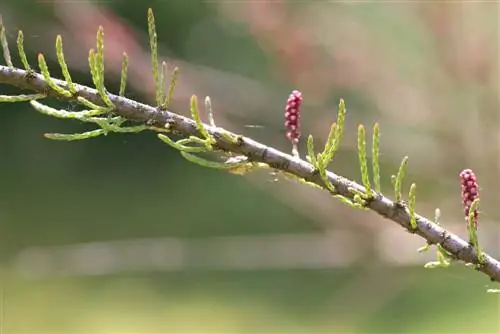
For hardy ornamental trees, such as the Tamarix ramosissima Rubra, the planting time is twice a year. The shrub grows both in autumn and early spring as long as the ground is not frozen. This is how it works step by step:
- Put the summer tamarisk you have propagated yourself or purchased ready-made in water
- Meanwhile, rake, weed and finely till the soil at the chosen location
- The ideal planting pit has twice the volume of the root ball
- Optimize the excavation with compost, manure, sand or granulated cattle manure
- Unpot the young bush, place it in the middle and water generously
For planting in a group or as a hedge, a distance of at least 150 centimeters is considered optimal.
Tip:
If you shorten the summer tamarisk by about a third in the last step of planting, this measure promotes further branching and growth.
Plants in pots
Thanks to its tolerance to pruning, the ornamental tree is recommended for cultivation in large containers. At exposed seats in the garden or on the terrace, the Tamarix serves as a decorative privacy and wind protection. If you place the shrub on the balcony, the considerable weight should be taken into account.
Structurally stable potted plant soil is the most suitable substrate in the planter. In contrast to commercial potting soil, it does not tend to compact. The addition of a handful of sand and perlite is recommended. The process of planting differs only slightly from planting it in the garden soil. The only thing worth emphasizing is the use of drainage over the water drain to protect against harmful waterlogging. Inorganic material such as grit, pebbles or crushed pottery shards are piled up to a height of 5 centimeters. Add a water- and air-permeable fleece between the substrate and the drainage to prevent soil crumbs from getting stuck.
Wintering
A summer tamarisk proves to be completely winter-proof in the bed. Until the ornamental shrub has become well established, light protection is recommended. During the year of planting, the root area should be piled up with leaves, straw or soil. The still young shoots are given a cover made of jute or garden fleece.
A Tamarix ramosissima Rubra in a pot, on the other hand, requires protection from frost every year. Since the root ball could freeze, the planter is wrapped thickly in bubble wrap or jute. Ideally, you should place the pot on an insulating surface made of wood or Styrofoam in front of the south wall of the house. If there is no snow to provide moisture, water the ornamental shrub in the bed and pot on a frost-free day.
Tip:
A tamarisk tree is neither fertilized nor cut from September onwards so that it fully matures before winter.
Conclusion
A summer tamarisk rounds off the ornamental and cottage garden in a meaningful way. Its lavish abundance of flowers thrives in both sunny and partially shaded locations and in any good garden soil. Thanks to its tolerance to drought, the Tamarix ramosissima Rubra adorns even delicate locations where strong winds can sometimes blow. The ornamental tree requires little care when it comes to care, as it is content with watering when it is dry and cutting in spring. If you would like more specimens, you can easily propagate them using cuttings.
Tips coming soon
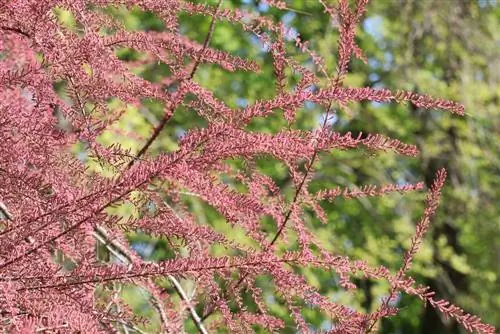
Location
- The location should be sunny.
- The more sun the plant gets, the better it develops.
- The tree requires neither winter nor wind protection and is very robust.
- The arching growth is best shown when the summer tamarisk stands free, as a solitary plant.
Planting substrate
- The soil must be permeable: a slightly sandy substrate, dry to fresh, is recommended.
- The pH value is slightly acidic to alkaline.
- The good thing is that the summer tamarisk also grows in nutrient-poor soil.
- This tamarisk does not cope well with heavy soils.
- The summer tamarisk doesn't like to be moved. She sometimes takes offense at that.
Watering and fertilizing
- The summer tamarisk comes from the south and therefore copes well with drought.
- It doesn't tolerate wetness well.
- A permeable and, if possible, drained soil is recommended so that excess water can drain away.
- Fertilization is not necessary.
Wintering
Wintering is not a problem. Summer tamarisks are tough and have good frost resistance
Cut
- Pruning is done in early spring.
- However, uncut summer tamarisks look the most beautiful.
- If you have to cut, then cut a lot. In any case, weak growth must be cut away!
- Flowered shoots are shortened to a strong side shoot.
- Pruning is recommended for young plants. To do this, shorten the shoots by half. This is how you get a good structure.
Propagation
- Summer tamarisks are easiest to propagate through cuttings.
- If you want to have a larger trunk straight away, take a rod that is about one meter long and at least as thick as a finger. The best time for propagating cuttings is early January. The rod is inserted about 40 cm deep into the ground (loosened). The cane rashes that appear are shortened by half.
- In the first year, this young shoot needs sufficient moisture. Watering is required when drought occurs. Fertilization is also recommended, preferably with liquid fertilizer, but diluted. From mid-July there is no more fertilization so that the wood can mature before the frost.

